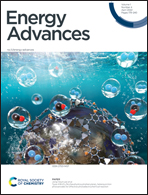Facile surface engineering of bio-waste derived amorphous carbon with SnO2 nanowires to enhance the efficacy of Li/Na storage†
Abstract
Amorphous carbon is expected to be an excellent material for rechargeable battery anodes if the specific capacity can be enhanced by fabricating a composite with an appropriate material. To the contrary, SnO2 exhibits a very high specific capacity as a Li/Na-ion battery anode due to its conversion-alloying mechanism, but low cycling stability confines its practical applications. Hence, we demonstrate the strategy of synthesizing a SnO2 composite with non-activated carbon (NAC) derived from jute stick using facile wet chemical dispersion followed by annealing, which is a cost effective and scalable approach. The facile synthesis strategy proves to be beneficial for the uniform decoration of SnO2 nanowires on the top of the NAC, which helps to compensate the volume expansion during the electrochemical reaction. The C/SnO2 composite exhibits improved electrochemical performance compared to the NAC with a specific discharge/charge capacity of 1657/868 mA h g−1 at 25 mA g−1 specific current with high rate and stability as a Li-ion battery anode. Upon assembling the composite with C/LFP as a cathode, the full cell delivers the maximum energy density of 384 W h kg−1 with an average voltage of 2.3 V. It also demonstrates Na-ion storage behavior with a specific charge capacity of 217 mA h g−1 at 25 mA g−1 specific current. Hence, the facile, scalable synthesis route and excellent battery performance of the aforementioned composite may endorse this pathway for the development of low-cost rechargeable battery anodes.

- This article is part of the themed collections: Sodium-ion batteries – Topic Highlight and Energy Advances: Highlight India


 Please wait while we load your content...
Please wait while we load your content...